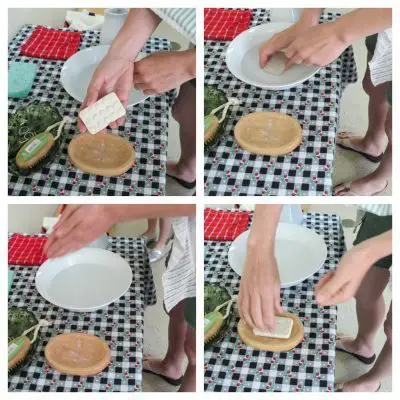Handwashing is one of my favorite practical life works in the Montessori early childhood classroom. There is such beauty to the lesson.
Some critics argue that washing hands with a pitcher and a basin is a thing of the past. They are missing out on a lovely process.
The child experiences a complete work cycle, benefits from cleaning hands thoroughly, practices caring for self and the environment, and prepares for sensorial lessons.

Learn Montessori’s Practical Life Handwashing Lesson
This handwashing lesson is part of the early childhood classroom, which includes children ages 3 through 6. Kids as young as two and a half could benefit from learning more about washing their hands.
Before this lesson, children should have mastered sponging and pouring water without spilling.
Handwashing Materials:
- Table
- Water
- Pitcher and bowl
- Soap
- Soap dish
- Nail brush
- Bucket
- Towel
- Sponge
- Mop
- Apron
- Lotion
How to Teach the Handwashing Presentation
Invite the child to do the work, remove jewelry, roll-up sleeves, and put on an apron.
Pick up the water pitcher and proceed to the faucet. Fill the pitcher 3/4 of the way with warm water. Bring the pitcher back to the bowl. Pour slowly, aiming for the center of the bowl. Place the pitcher back in its place or to the side.
Immerse both hands into the water, putting hands flat and palms down to get both sides wet. Let your hands sit in the water. Shake hands over the bowl to release any drops. Then lift them out over the bowl.
Pick up the soap with the dominant hand, wet the soap, and rub it between the palms. Replace the soap in the dish and continue rubbing your hands front and back. Be sure to go past the wrists and between your fingers to the tips. Immerse both hands in the water to rinse, palms down. Turn hands over and rinse the back of the hands.

Wet the nail brush, and then brush it over the soap several times. Cup the hands with palms facing towards you. Scrub the brush back and forth, with the brush facing down and the hands closer to the water. Turn the hand and brush the tops of nails. Repeat with the other hand. Rinse the brush, shake gently to get the remaining water out, and put the brush back.
Rinse hands again, lift them out of the water, and shake off excess water. Take a towel and dry your hands, making sure to get in between the fingers. Place the towel to the side of the bowl, letting the child know that you’ll be using it to clean up.
Grasp both sides of the bowl and pour into the bucket. Bring the bowl back to the table and wipe up excess water with a sponge. Empty the bucket. Wipe the bucket and the pitcher with the sponge.
Wipe up any spills with the towel or sponge. Put the pitcher back into the bowl.
Take the towel to the dirty towel basket, and replace the towel with a fresh one for the next person to use.
Use a small amount of hand lotion and massage it slowly into your hands using the same motions used when washing the hands.
Roll down your sleeves and replace jewelry.
Ask the child if he would like a turn.
Additional Elements of the Montessori Handwashing Lesson
Below are more key ingredients of the traditional Montessori lesson. Understanding each of these elements will help when preparing the work for children.
Control of Error allows the child to take the lead in her own learning via direct feedback.
- Visual discrimination – are your hands really clean?
- Spilled water
- Too much lotion
- Too much soap
- Damp hands
These Points of Interest engage a child more fully in the lesson. Be sure to draw his attention to them.
- Water
- Smell & texture of the soap
- Using a pitcher to pour
- Bubbles
- Dripping
- Shaking hands
- Nail brush bristles touching hands
These are the Direct Aims of the handwashing lesson.
- Independence
- Coordination
- Order
- Concentration
Indirect Aims of this lesson include the following.
- Hand-Eye Work
- Thermic discrimination with water temperature
- Preparation for use of sensorial materials
- Cleaning hands
- Hygiene (Care of Self)
This practical life lesson also gives the child ample opportunity to develop her Language. Some words to explore with the lesson are – pitcher, bowl, tepid, warm, cool, bristle, fingernail, lather, foam, scum, and germs.
Resources Mentioned in this Post
- Handwashing materials from Montessori Services
- Our favorite bar soap
- Nail brush for kids
- Excellent hand towels
How do you teach the Montessori handwashing lesson? Do you use the traditional pitcher and basin, or do you take a different approach?
